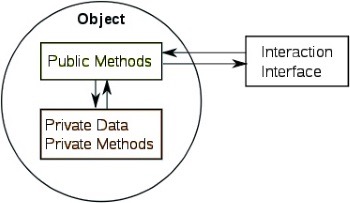Type embedding: Golang’s fake inheritance | DoltHub Blog
Differences between Procedural and Object Oriented Programming - GeeksforGeeks
Differences between Procedural and Object Oriented Programming
The SOLID Principles of Object-Oriented Programming Explained in Plain English
为什么老鸟要告诉你优先使用组合而不是继承?
Object Oriented Programming in Go
Dependency inversion principle
embedding
Composition over Inheritance
Trying Clean Architecture on Golang
The Clean Architecture
The Clean Architecture — Beginner’s Guide
Object Oriented Inheritance in Go
Object-Oriented Programming in GO
Explaining Clean Architecture
program paradigm
program: a set of instructions
program paradigm:
- 一系列理念和方法, a set of concept,practice and approaches to code
- 编码的方式
types
- 命令式, imperative: 如何做
- procedural
- oop
- declarative: 做什么,比如 sql, select data from table1, 查询出 data 数据,不管如何具体查
- 函数式
- reactive
- domain-specific language:
- sql
- html
oop vs procedural:
| parame |
procedural |
oop |
| 程序划分为 |
function |
object |
| maintain |
easy |
hard |
| code reusability |
no |
inheritance |
| Priority |
function |
data |
| access modifier |
no, less secure |
yes |
| abstrct |
无 |
基于现实世界进行抽象 |
procedural
1
2
3
4
5
6
7
8
9
10
11
12
13
14
|
# Procedure to calculate the area of a rectangle
def calculate_area(length, width):
area = length * width
return area
# Prompt user for input
length = float(input("Enter the length of the rectangle: "))
width = float(input("Enter the width of the rectangle: "))
# Calculate area using the procedure
area = calculate_area(length, width)
# Display result
print("The area of the rectangle is:", area)
|
oop
1
2
3
4
5
6
7
8
9
10
11
12
13
14
15
16
17
18
19
20
|
# Rectangle class
class Rectangle:
def __init__(self, length, width):
self.length = length
self.width = width
def calculate_area(self):
area = self.length * self.width
return area
# Prompt user for input
length = float(input("Enter the length of the rectangle: "))
width = float(input("Enter the width of the rectangle: "))
# Create Rectangle object and calculate area
rect = Rectangle(length, width)
area = rect.calculate_area()
# Display result
print("The area of the rectangle is:", area)
|
good code: 易维护代码
- 隔离变化: 易修改/拓展
- 少冗余
- 高 复用
oop
what
oop:
- 模拟真实世界,构建出对象, 通过对象之间的交互完成相关逻辑
- 通过封装继承多态构建出好的代码
the pros:
- 封装: 模块化 ,隔离变化, 容易维护
- 继承:代码复用,减少冗余
- 多态: 可拓展性
go isn’t prue oop:
- go缺失了继承
- go 没有其他oop语言里常见元素: class, construtctor
- 封装支持的level只有 public and private
highlight:
- 抛弃了oop的繁重的inherit and class
- 使用简单的方式实现oop
principle
what’s principle:
- 原则,原理, 指导方针, 实现oop 的基础
four principle in oop
- 抽象:
- 封装
- 继承
- 多态
Encapsulation

also: hiding info
what: 将数据和方法打包到一个对象中,并只开放必要方法访问和操作数据
1
2
3
4
|
class person:
privated int age;
public AddAge(int year):
age+= year
|
in go: methods + low,uppercase
1
2
3
4
5
6
|
type Person struct{
age int
}
func (p *Person)AddAge(int year){
p.age+=year
}
|
example:
1
2
3
4
5
6
7
8
9
10
11
12
13
14
15
16
17
18
19
20
21
22
23
24
25
|
public class Person {
private String name;
private int age;
public Person(String name, int age) {
this.name = name;
this.age = age;
}
public String getName() {
return this.name;
}
public int getAge() {
return this.age;
}
public void setAge(int age) {
if (age >= 0 && age <= 120) {
this.age = age;
} else {
throw new IllegalArgumentException("Age must be between 0 and 120.");
}
}
}
|
how go do it
- 使用type and methods 模仿 class,
- 使用大小写控制访问权限: packge level
1
2
3
4
5
6
7
8
9
10
11
12
|
type Person struct {
name string // private
}
func (p *Person)GetName()string{
return p.name
}
func (p *Person)SetName(name string)string {
p.name = name
}
|
inherit
what: 直接获得已有对象的属性和方法
pros: 代码复用,减少冗余
cons: 父类与子类强耦合,不易于维护
inherit in go
go 没有继承,只有组合:
- 普通组合: 成员变量
- 内嵌: 匿名成员变量
1
2
3
4
5
6
7
8
|
type Dog struct{
Base Animal
}
type Dog struct{
Animal
}
|
embed: 可以直接调用匿名成员变量的属性和方法
为什么 embeded不是继承:
- 没有多态的特性: B is A; var B A;
- 无法重写方法
1
2
3
4
5
6
7
8
9
10
11
12
13
14
15
16
17
18
19
20
21
22
23
24
25
26
27
28
29
30
31
|
package main
import "fmt"
type Person struct {
}
func (p *Person) Greet() {
var n = p.Name()
fmt.Println("hello:",n)
}
func (p *Person) Name() string {
return "default"
}
type Male struct {
*Person
}
func (m *Male) Name() string {
return "tony"
}
func main() {
var f Male
f.Greet() // expected "hello:tang "
}
|
是组合的语法糖
1
2
|
f.Greet()== f.Person.Greet()
f.Name == f.Person.Name
|
polymorphism
what: 不同形态(object)响应相同的接口
pros:
- 可拓展性
in java: 继承 and interface
1
2
3
4
5
6
7
8
9
10
|
class Animal:
makesound:
class Dog extends Animal:
makesound:
class Bird implemnts Aninal:
makesound
|
polymorphism in go
limit: go只能 使用interface实现多态
highlight: 不需要显式的指定 实现interface
interface example :
1
2
3
4
5
6
7
8
9
10
11
12
13
14
15
16
17
18
19
20
|
type Bird interface {
fly()
}
type Eagle struct {}
func (e *Eagele)fly(){
....
}
func main() {
var ma Bird = Mahjong{"mahjong"}
var a Bird = Eagle{"Eagle"}
var birdList = []Bird{ma, a}
for _, v := range birdList {
v.fly()
}
}
|
